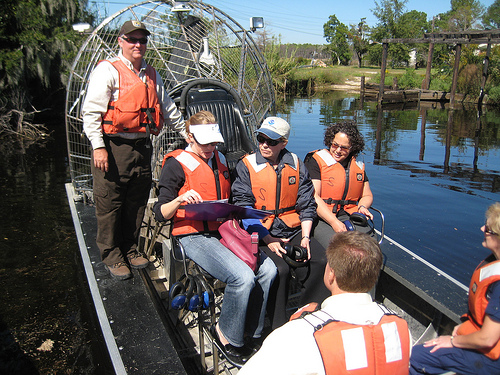
Last week, I joined fellow members of the Ocean Policy Task Force in New Orleans for a Public Meeting to continue our ongoing discussion of ocean and coastal environmental issues, this time with a focus on the Gulf Coast Region. At the meeting on Monday, we heard a wide variety of comments from local residents and gained valuable insight into the central issues affecting the region that was devastated by Hurricane Katrina just over four years ago. In addition to being there in person, we were able to virtually link all five Gulf states thanks to the Gulf Coastal Ecosystem Learning Centers, and had the benefit of live participants from Corpus Christi, TX; Tampa, FL; Dauphin Island, AL; Ocean Springs, MS as well as New Orleans, LA. The lessons learned from this trip once again highlight the need for a national policy that ensures the protection, maintenance, and restoration of our oceans, coasts, and marine ecosystems.
On Tuesday, we toured the Gulf Coast region to get a first-hand view of the issues. We took an aerial tour of New Orleans’ 9th Ward, coastal wetlands and barrier island chains, and the Mississippi river, followed by an airboat tour of the Big Branch Marsh National Wildlife Refuge and its unique habitats and diverse plant communities. Our trip allowed us to see both the bird’s eye view of the Gulf from the air, and actual restoration efforts on the ground. The Obama administration is working to strengthen the wetlands and barrier islands that are the first line of defense for the Gulf Coast – a priority that, while critical to this region’s physical protection, is also critical to our environment and to our economy.
It was a truly pleasure to return to New Orleans so soon after my visit the week before. Before the President’s town hall, I had the opportunity to meet with leaders from the community engaged in coastal restoration efforts and to witness first-hand the degree of environmental degradation plaguing the region. I also visited the Central Bayou Bienvenue wetlands restoration site, which is utilizing wetland assimilation of wastewater effluent to restore approximately 10,000 acres of the critical cypress wetlands that have historically served as a natural defense against storms.
Standing on the viewing post of Bayou Bienvenue and seeing the extent to which the wetlands have disappeared was a humbling experience that reinforced my belief in the importance of this, and other coastal restoration projects. As the President said during the Town Hall, it is inspirational to spend time with the citizens there who have persevered in the face of the tragedy that was Katrina and are steadfast in their resolve to rebuild. The Obama Administration is committed to enhancing the environmental and economic sustainability of New Orleans and coastal Louisiana, and we recognize that coastal wetland restoration is a key path toward achieving this type of long-term resiliency. I would like to thank the individuals who provided us with valuable insight on the restorative work being accomplished there, and I look forward to continue to work with this region in the future.
Nancy Sutley is the Chair of the Council on Environmental Quality.



